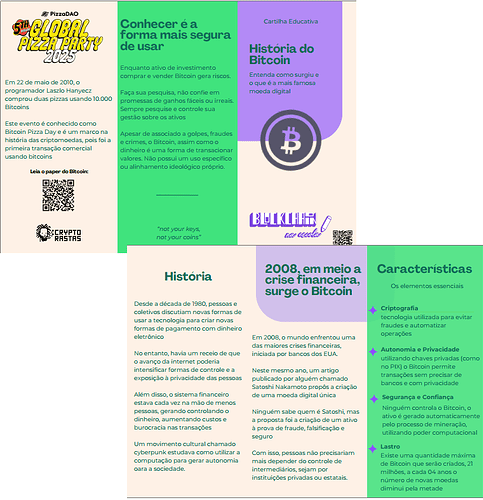We’re excited to share our Semestral Report 2025, detailing how we’ve been driving real Web3 adoption in Latin America over the last 6 months. From innovative educational pilots to developer training, cultural events, and business partnerships.
Twitter: https://x.com/BlckNaEscola/status/1943375312684728380
NFT Certificates Collection: BnE.EduLATAM NFTs on Rarible: Buy, Sell and Trade
How can we drive real adoption of Web3 in LATAM?
We have been working in education for the last 3 years, seeing blockchain as a disruptive technology for social justice. Our goal in Web3 is to hack these technologies to create real solutions for our local challenges.
In the Global South, dystopia arrived earlier. That’s why cyberculture principles, more than temporal hype, are local strategies for the future. Digital technology can become a powerful alternative for collectives and social groups.
For example, in some Brazilian communities, students lose nearly two years of schooling due to violence and frequent shootings.
This is one reason we focus on public schools: these are future generations at risk of being excluded from new technologies, markets, and careers. Many on our team come from these same communities.
Educational Business Development
Ok, we assume the social impact of the project, but is it sustainable? How can a project with purely social goals sustain itself? Are we a philanthropic entity? Definitely not. That’s why we need autonomy and a sustainable business model.
To try to answer these questions, over the last 6 months, we tested various educational strategies. After successful pilots, we’re now building a profitable business structure around technology.
The market opportunity for web3 protocols
We recently published insights from a study by Electric Capital that examined developer activity across major blockchain networks.
The data shows emerging regions have doubled the number of active devs and infrastructure creation, in part due to investments in communities, education, and real adoption.
We believe reaching these markets, especially by investing in developers and local talent, is a strategic move for blockchain networks. It also serves as social proof for local communities, authorities, and investors.
MVP: Celo Educational Methodology
Before this new wave of mini dApps and the boom of AI and vibe coding, at the start of the year, we began building an educational learning system to onboard and certify students. Now, with Celo’s evolving tech stack, all of this can be taken further.
First, we secured a strategic partnership as an official partner of one of the largest crypto events in Brazil this year. This allowed us to create the first large-scale onboarding of hundreds of students into the Web3 ecosystem.
We built an environment where students had their first contact with wallets and blockchain, learning Web3 basics, digital finance, and tokenization, so they arrived at the event already prepared.
On top of Celo’s infrastructure, in January and February, we launched the Edu LATAM program, developing low-cost blockchain courses in HQ Comic style, infused with cyberpunk culture, all on Celo & Valora.
The results were impressive. Even during school vacations and on the eve of Brazil’s biggest holiday (Carnival), by using art and culture as educational tools, we reached over 1,200 students and issued around 840 certifications in just 2 months. This means we were averaging 20 on-chain certifications per day on Celo, using Valora.
Developer training & real outcomes
During this same 6-month period, we also ran a developer training program in partnership with 42 Rio, teaching Solidity and smart contract development.
A team formed by students from this course went on to win a prize at the $25K Modular Carnival hackathon, proving how local capacity building can quickly translate into real impact and visibility within the Web3 ecosystem.
We also hosted a Global Pizza Party with Cryptorastas, strengthening Web3 culture on the ground and creating new spaces for community learning and engagement.
Development aligned with local context, challenges and culture
Celo has enormous market potential in LATAM, in Brazil, for typical Web3 opportunities around payments and finance, but especially because of its mobile-first focus.
On our side, we’re committed to building the necessary adaptations for local realities. We know there’s a wide variety of educational content out there, some already translated and online. But we believe some strategies can truly drive real adoption.
Blockchain still faces adoption barriers, often linked in public opinion to scams or speculation, amplified by conservative sectors. Meanwhile, deep-rooted educational and social gaps limit its reach.
In the link, we share more of our activities this year and how we used art and culture as pedagogical tools, plus why we believe next-gen digital technologies like AR, VR glasses, 3D printing, and virtual reality should also be integrated.
Call to Action
We continue to engage with the Celo ecosystem, now with a stronger focus on integration with local businesses and institutions.
We’ve proven we can mobilize communities, onboard first-time users, and build genuine engagement through events, culture, and educational content — unlocking a real market for Web3 in Latin America.
Now we want to take this to the next level:
![]() Scale integrations with Celo tools (like Divvy, AI. Mini dApps)
Scale integrations with Celo tools (like Divvy, AI. Mini dApps)
![]() Keep nurturing local devs & driving new user adoption
Keep nurturing local devs & driving new user adoption
![]() Would love to hear your thoughts, feedback, or ideas for partnerships.
Would love to hear your thoughts, feedback, or ideas for partnerships.
How else can we strengthen this and push Celo adoption even further across LATAM?


